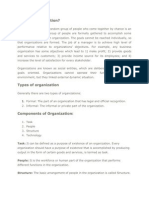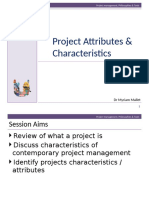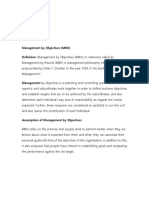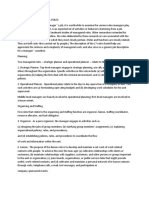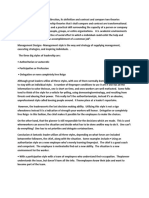Top-Level Management: Core Characteristics
Top-Level Management: Core Characteristics
Uploaded by
Zach YolkCopyright:
Available Formats
Top-Level Management: Core Characteristics
Top-Level Management: Core Characteristics
Uploaded by
Zach YolkOriginal Title
Copyright
Available Formats
Share this document
Did you find this document useful?
Is this content inappropriate?
Copyright:
Available Formats
Top-Level Management: Core Characteristics
Top-Level Management: Core Characteristics
Uploaded by
Zach YolkCopyright:
Available Formats
Top-Level Management
Core Characteristics
High level managers tend to have a substantial amount of experience, ideally across a wide variety of functions. Many
become part of an executive team through mastering their functional disciplines across various roles, become the Chief
Operations Officer (COO), Chief Marketing Officer (CMO), Chief Technology Officer (CIO or CTO), Chief Financial
Officer (CFO) or Chief Executive Officer (CEO).
Top management teams are also often industry experts, having a close association with the long term trajectory of the
businesses they operate in. They often benefit from being charismatic, powerful communicators with a strong sense of
accountability, confidence, integrity and a comfort with risk.
Responsibilities
The primary role of the executive team, or the top-level managers, is to look at the organization as a whole and derive
broad strategic plans. Company policies, substantial financial investments, strategic alliances, discussions with the board,
stakeholder management and other top-level managerial tasks are often high-risk high return decision-making initiatives
in nature. Top-level management roles are therefore often high stress and high influence roles within the organization.
TOP LEVEL MANAGEMENT ROLES IN A COMPANY
The Chief Executive Officer (CEO) is the person who reports to the board of directors. This manager is the highest
ranking manager in the organization. The CEO develops the strategy of the company and is response for its success. Part
of the CEO’s responsibilities include meeting other top level managers and ensuring their areas of work are in line with
his vision. The main role of this manager is to macro manage and provide vision. The CEO usually leaves operations and
performance details to the middle level management.
The Chief Operating Officer (COO) is the second-ranking manager in a company. This professional is response for the
daily operations of the organizations. The COO reports directory to the CEO. The typical work of this manager is
‘behind-the-scenes’ and is usually focused on implementing the CEO’s vision by using available company resources.
The COO is also in charge of monitoring results, efficiency and performance.
The Chief Financial Officer (CFO) manages on a macro level the organization’s finances. The CFO meets with other
top level management to discuss and approve financial plans and budgets. Probably the most important function of the
CFO is ensuring that financial controls meet all regulations, payment obligations and tax reporting.
The Chief Information Officer (CIO) oversees the technological needs of an organization. This specialist determines
how computer systems and networks are implemented and maintained. The CIO frequently meets with the COO and
CFO to discuss forecasts and technological requirements. A successful CIO must come from information computing
background, as he must manage the use of hardware, software and networks in a company. Here’re some of the other
responsibilities chief information officers have:
Data security
Networking needs
Outsourcing computing needs
Seminar and conference attendances
Functions of top level management:
The main functions of top level management are as follows:
(a) Determine objectives for the organisation: Objectives may relate to profit, business growth, survival, prestige,
competitive pricing, marketing method, widening the area of sales, relations with workers, customers, public etc.
(b) Frame the policy: To frame the policy and chalk out the plans to carry out the objectives and policies. Policies may
relate to different aspects of the organisation. For example, production policy deals with the quality, product variety,
scheduling of production to meet the market demand etc.
1) Market policy: this policy deals with such matters as advertising and sales promotion techniques, pricing product,
channel of distribution, commission, discount, placements, training, remuneration promotion, appraisal of performance
etc. of the personnel.
2)Financial policy: This relates to the procurement of funds, source of finance, management of earning, etc.
(c)Organisational Frame Work: Top management determines the organisational structure for the purpose of executing
the plans that have been laid down. Execution of plans is necessary to carry out the objectives and policies.
(d)Assemble the Resources: For the purpose of executing the plans, the resources of men, machines, materials and
money have to be assembled. This again is the task of top management.
(e)Control the operations through organisation: Controls the top management regarding operations through budgets,
cost and statistics quality control and accounting devices.
You might also like
- The Changing Marketing LandscapeDocument14 pagesThe Changing Marketing Landscapeagatha linusNo ratings yet
- Cultural Factors Influence Customer BehaviorDocument2 pagesCultural Factors Influence Customer BehaviorNishitDilipShahNo ratings yet
- (Economic Themes) Impact of National Culture On International Human Resource ManagementDocument20 pages(Economic Themes) Impact of National Culture On International Human Resource ManagementAshleyKumarNo ratings yet
- The Power SchoolDocument17 pagesThe Power SchoolWaqar Afzaal100% (1)
- Handouts in Business EthicsDocument2 pagesHandouts in Business EthicsAimelenne Jay AninionNo ratings yet
- The Organizational Socialization ProcessDocument6 pagesThe Organizational Socialization ProcessTimofte CristianNo ratings yet
- Ch-8 (Managing Products, Product Lines, Brands, Packaging)Document18 pagesCh-8 (Managing Products, Product Lines, Brands, Packaging)Priyanka BujugundlaNo ratings yet
- LESSON Myths of Entr. ShipDocument15 pagesLESSON Myths of Entr. ShipChristopherNo ratings yet
- 10 ReactionDocument6 pages10 ReactionKarl Jason Dolar CominNo ratings yet
- Block Categories HaryanaDocument5 pagesBlock Categories HaryanaZach YolkNo ratings yet
- Importance of Strategic Management in An OrganizationDocument2 pagesImportance of Strategic Management in An OrganizationJoshua BlessingNo ratings yet
- The Nature and Scope of Organizational Behavior: ObjectivesDocument18 pagesThe Nature and Scope of Organizational Behavior: ObjectivesLords Porseena100% (1)
- Topic - 3 (Management Function - Staffing)Document6 pagesTopic - 3 (Management Function - Staffing)Saffa IbrahimNo ratings yet
- What Is ManagementDocument15 pagesWhat Is ManagementAvery Jan SilosNo ratings yet
- Gate 3 - Execution - Machinery, Methods, and Management SkillsDocument35 pagesGate 3 - Execution - Machinery, Methods, and Management SkillsJohn Nelo MorataNo ratings yet
- What Are The Major Functions of An OrganizationDocument5 pagesWhat Are The Major Functions of An Organizationjohn3d100% (4)
- Business Ethics - RobinDocument29 pagesBusiness Ethics - RobinRobin ShahNo ratings yet
- LBC PaperDocument12 pagesLBC PaperShaina DalidaNo ratings yet
- Organization and Management Assignment 1Document2 pagesOrganization and Management Assignment 1Erica Jaztine AranetaNo ratings yet
- Report The Organizational Development PractitionerDocument41 pagesReport The Organizational Development PractitionerGino Villeras IlustreNo ratings yet
- Chapter 8 Training & DevelopmentDocument21 pagesChapter 8 Training & DevelopmentSalman PreeomNo ratings yet
- Strategic Management - Module 4 - Strategy ImplementationDocument4 pagesStrategic Management - Module 4 - Strategy ImplementationEva Katrina R. LopezNo ratings yet
- Human Resources Management CH 01Document58 pagesHuman Resources Management CH 01karim kobeissi100% (1)
- Chapter-11: Basic Elements of OrganizingDocument24 pagesChapter-11: Basic Elements of OrganizingKanak 8064No ratings yet
- Policies - Part 1 Organizational PoliciesDocument10 pagesPolicies - Part 1 Organizational PoliciesNghĩa Sáng HoàngNo ratings yet
- Entrepreneur Vs IntrapreneurDocument6 pagesEntrepreneur Vs IntrapreneurHimadhar SaduNo ratings yet
- Part 5: Controlling Chapter 13 - Foundations of Control: Learning OutcomesDocument17 pagesPart 5: Controlling Chapter 13 - Foundations of Control: Learning OutcomesShahana KhanNo ratings yet
- Humms 12A Entrepreneurship - Strategic Planning and Business DevelopmentDocument7 pagesHumms 12A Entrepreneurship - Strategic Planning and Business DevelopmentChristian RiveraNo ratings yet
- MBS 3rd Semester International BusinessDocument135 pagesMBS 3rd Semester International BusinessfierceaadarshaNo ratings yet
- Project Attributes & Characteristics - TaggedDocument15 pagesProject Attributes & Characteristics - Taggedsandesh kalathilNo ratings yet
- Case Study 1Document9 pagesCase Study 1Lyka NaboaNo ratings yet
- Narrative ReportDocument1 pageNarrative Reportharvey100% (1)
- Eo Chapter 1Document3 pagesEo Chapter 1Pedro Vizcaino DelgadoNo ratings yet
- DepartmentalizationDocument2 pagesDepartmentalizationAreissa JamesNo ratings yet
- Types of PlanningDocument8 pagesTypes of PlanningkrithikuttyNo ratings yet
- Group Decision MakingDocument16 pagesGroup Decision MakingMonir H. Mazumder100% (1)
- G Mango FM Essentials Handbook 2016Document210 pagesG Mango FM Essentials Handbook 2016drmsola9803100% (2)
- Topic 4 Culture and LeadershipDocument24 pagesTopic 4 Culture and LeadershipCARLVETT ELLENNE JUNNENo ratings yet
- Business Policy SyllabusDocument2 pagesBusiness Policy SyllabusAlbert Macapagal100% (1)
- Environmental Forecasting: Meaning and Techniques Deepali Hiremath Assistant ProfessorDocument21 pagesEnvironmental Forecasting: Meaning and Techniques Deepali Hiremath Assistant ProfessorJessuel Larn-epsNo ratings yet
- Impact of Leadership Styles On Employee Performance Parks DuncanDocument31 pagesImpact of Leadership Styles On Employee Performance Parks DuncancintoyNo ratings yet
- What Is ManagementDocument259 pagesWhat Is Managementronalit malintadNo ratings yet
- Dr. Filemon C. Aguilar Memorial College of Las PiñasDocument11 pagesDr. Filemon C. Aguilar Memorial College of Las PiñasKimberly MondejarNo ratings yet
- Characteristics of A Well-Written ObjectivesDocument15 pagesCharacteristics of A Well-Written ObjectivesRamil GofredoNo ratings yet
- What Is Strat - ManDocument6 pagesWhat Is Strat - ManJohn Michael Antonio CuaNo ratings yet
- Finance ReflectionDocument7 pagesFinance ReflectionItai Francisco ViegasNo ratings yet
- Om-Chapter4-The WorkplaceDocument30 pagesOm-Chapter4-The WorkplaceNhormer PedrinaNo ratings yet
- Leadership IntroductionDocument1 pageLeadership Introductionp.sankaranarayananNo ratings yet
- Transaction Processing SystemDocument17 pagesTransaction Processing SystemRowdy RahulNo ratings yet
- What Is ManagementDocument26 pagesWhat Is ManagementDel Farai BalenguNo ratings yet
- PROJECT IN MANAGEMENT PrelimDocument12 pagesPROJECT IN MANAGEMENT PrelimMitchelle Labitag RiveraNo ratings yet
- 17 Managerial RolesDocument4 pages17 Managerial RolesCris King BiaoNo ratings yet
- 1.6challenges and Opportunity For Organization Behaviour 1Document13 pages1.6challenges and Opportunity For Organization Behaviour 1Balakrishna Nalawade N0% (1)
- Reflection On The 3rd Habbit - Put First Things FirstDocument2 pagesReflection On The 3rd Habbit - Put First Things FirstMegan Princess Amazona- SuicoNo ratings yet
- Police Personnel PoliciesDocument3 pagesPolice Personnel PoliciesMark Jayson Pampag MuycoNo ratings yet
- Leadership ComparisionDocument6 pagesLeadership ComparisionLearnEasy by AmarjeetNo ratings yet
- Chapter 7 - ControllingDocument10 pagesChapter 7 - ControllingMuhammad Irfan100% (1)
- BEN 4401 Entrepreneurship Skills TOPIC 6 Theories of EntrepreneurshipDocument13 pagesBEN 4401 Entrepreneurship Skills TOPIC 6 Theories of EntrepreneurshipJayb WatuaNo ratings yet
- Recruitment Process Outsourcing A Complete Guide - 2020 EditionFrom EverandRecruitment Process Outsourcing A Complete Guide - 2020 EditionNo ratings yet
- MBA General Syllabus Computer Applications in ManagementDocument1 pageMBA General Syllabus Computer Applications in ManagementZach YolkNo ratings yet
- MBA General SyllabusDocument52 pagesMBA General SyllabusZach YolkNo ratings yet
- Nainital: Format For Technical BidDocument2 pagesNainital: Format For Technical BidZach YolkNo ratings yet
- Tender Premises 122020Document2 pagesTender Premises 122020Zach YolkNo ratings yet
- Work Motivation: Theory and PracticeDocument10 pagesWork Motivation: Theory and PracticeZach YolkNo ratings yet
- Work Motivation Theory and Research at The Dawn of The Twenty-First Century - Annual Review of PsychologyDocument11 pagesWork Motivation Theory and Research at The Dawn of The Twenty-First Century - Annual Review of PsychologyZach YolkNo ratings yet
- Nainital: Format For Financial BidDocument1 pageNainital: Format For Financial BidZach YolkNo ratings yet
- HBD5741 - 21 Lecture Classes Begin Promptly at 6Document6 pagesHBD5741 - 21 Lecture Classes Begin Promptly at 6Zach YolkNo ratings yet
- The Social Motivation Theory of Autism DocumentedDocument13 pagesThe Social Motivation Theory of Autism DocumentedZach YolkNo ratings yet
- Work Motivation Theory and Research at The Dawn of The Twenty-First Century - Annual Review of PsychologyDocument11 pagesWork Motivation Theory and Research at The Dawn of The Twenty-First Century - Annual Review of PsychologyZach YolkNo ratings yet
- This Introduction Represents An Overview of The Field of Work Motivation From A Theoretical Standpoint and LDocument11 pagesThis Introduction Represents An Overview of The Field of Work Motivation From A Theoretical Standpoint and LZach YolkNo ratings yet
- Freedom CMP Faq Store Online - Buy Freedom CMP Faq Online at Best Price in IndiaDocument4 pagesFreedom CMP Faq Store Online - Buy Freedom CMP Faq Online at Best Price in IndiaZach YolkNo ratings yet
- Item-Nonresponse and The 10-Point Response Scale in Telephone SurveysDocument7 pagesItem-Nonresponse and The 10-Point Response Scale in Telephone SurveysZach YolkNo ratings yet
- Asian Journal of Distance Education: Swayam-Indian Moocs: An Insider'S PerspectiveDocument9 pagesAsian Journal of Distance Education: Swayam-Indian Moocs: An Insider'S PerspectiveZach YolkNo ratings yet
- Quality Assurance in Asian Distance Education: Diverse Approaches and Common CultureDocument21 pagesQuality Assurance in Asian Distance Education: Diverse Approaches and Common CultureZach YolkNo ratings yet
- Manual of Instructions On Service Matters - Part I - Haryana - D03225 PDFDocument518 pagesManual of Instructions On Service Matters - Part I - Haryana - D03225 PDFZach YolkNo ratings yet
- Lok Sabha - Corrigenda To The Electricity (Amendment) Bill, 2014 (To Be/as Introduced in Lok Sabha)Document4 pagesLok Sabha - Corrigenda To The Electricity (Amendment) Bill, 2014 (To Be/as Introduced in Lok Sabha)Zach YolkNo ratings yet
- Top Level ManagementDocument2 pagesTop Level ManagementZach YolkNo ratings yet
- E-Aadhar Bhavi DhouchakDocument1 pageE-Aadhar Bhavi DhouchakZach YolkNo ratings yet
- Functions of Communication and Media Issues in Philippine Media 1Document14 pagesFunctions of Communication and Media Issues in Philippine Media 1Zach YolkNo ratings yet
- Introduction To Hospitality IndustryDocument138 pagesIntroduction To Hospitality IndustryRupali MohantyNo ratings yet
- Unit 1 Production of Audlonldeo Programmes: An Overview: StructureDocument18 pagesUnit 1 Production of Audlonldeo Programmes: An Overview: StructureZach YolkNo ratings yet
- Front Office Theory I YearDocument40 pagesFront Office Theory I YearManoj Sharma100% (2)
- Be or Modal Verbs (Can, Must, Might, Should Etc.)Document4 pagesBe or Modal Verbs (Can, Must, Might, Should Etc.)Zach YolkNo ratings yet
- Reservation Systems and MethodeDocument31 pagesReservation Systems and MethodeRavi Ranjan100% (3)
- Hotel Front Office Common Terms Part 1Document18 pagesHotel Front Office Common Terms Part 1Zach YolkNo ratings yet
- RA No. 11032: Ease of Doing Business and Efficient Government Service Delivery Act of 2018"Document17 pagesRA No. 11032: Ease of Doing Business and Efficient Government Service Delivery Act of 2018"clara san miguelNo ratings yet
- ADPP SyllabusDocument2 pagesADPP SyllabusMalik WaqarNo ratings yet
- Applicant Nomination Form: Part One: About The ApplicantDocument2 pagesApplicant Nomination Form: Part One: About The ApplicantWaqar Akbar KhanNo ratings yet
- 1.introduction To Business, Strategy, Objectives and PolicyDocument39 pages1.introduction To Business, Strategy, Objectives and PolicyJigar Patel0% (1)
- International LawDocument2 pagesInternational LawjisooNo ratings yet
- Summary Report of Rep FofanaDocument20 pagesSummary Report of Rep FofanaSekou Koutoubou FofanaNo ratings yet
- Sms FrameworkDocument62 pagesSms FrameworkJean-Michel ZituNo ratings yet
- Principles For Federal Engagement in Standards Activities To Address National PrioritiesDocument4 pagesPrinciples For Federal Engagement in Standards Activities To Address National PrioritiesFedScoopNo ratings yet
- Rural District Planning in Ghana: A Case StudyDocument83 pagesRural District Planning in Ghana: A Case StudyNurul PutriNo ratings yet
- AS20103 Teori Hubungan Antarabangsa: Tradisional Approaches-Behavioralism, Neoliberal-NeorealismDocument28 pagesAS20103 Teori Hubungan Antarabangsa: Tradisional Approaches-Behavioralism, Neoliberal-NeorealismNickKyNo ratings yet
- First Ann - Ual Message To The National Congress: Salvador Allende ReaderDocument13 pagesFirst Ann - Ual Message To The National Congress: Salvador Allende ReaderEzequiel ZaidenwergNo ratings yet
- IOSA SMS Strategy April 2013Document44 pagesIOSA SMS Strategy April 2013vamrneNo ratings yet
- Ra 11479-Terrorism Law of 2020Document25 pagesRa 11479-Terrorism Law of 2020Christian Dave Tad-awanNo ratings yet
- Social Policy and Administration-1-1Document26 pagesSocial Policy and Administration-1-1fnyonga7No ratings yet
- ANANDAM - (SEM - 2) HarshDocument19 pagesANANDAM - (SEM - 2) Harshdasharthsingh4303No ratings yet
- Understanding How Volunteering Creates Stronger Communities: A Literature ReviewDocument39 pagesUnderstanding How Volunteering Creates Stronger Communities: A Literature ReviewNCVO100% (1)
- Critical Areas and Projects. The President of The PhilippinesDocument2 pagesCritical Areas and Projects. The President of The PhilippinesKIM COLLEEN MIRABUENANo ratings yet
- Peronism and The Birth of Modern Populism: Enrique PeruzzottiDocument12 pagesPeronism and The Birth of Modern Populism: Enrique Peruzzottiعلي سامي يوسفNo ratings yet
- 2018 EPI Results - Environmental Performance IndexDocument9 pages2018 EPI Results - Environmental Performance IndexxeniaNo ratings yet
- The Teaching Profession - Chapter 4Document4 pagesThe Teaching Profession - Chapter 4George Kevin Tomas100% (1)
- Graft and Corruption: Philippine Social Realities and Social WelfareDocument23 pagesGraft and Corruption: Philippine Social Realities and Social WelfareSandra ManansalaNo ratings yet
- The Poor Sanitation and Access To Clean Water in Some Areas of Brgy. Cabezas, Trece Martires City, Cavite During The COVID 19 PandemicDocument2 pagesThe Poor Sanitation and Access To Clean Water in Some Areas of Brgy. Cabezas, Trece Martires City, Cavite During The COVID 19 PandemicteuuuuNo ratings yet
- Nptel: Introduction To Law On ElectricityDocument16 pagesNptel: Introduction To Law On ElectricityRavi ShankarNo ratings yet
- Assessment Form - TAXN6045 2020.2Document8 pagesAssessment Form - TAXN6045 2020.2bagasNo ratings yet
- Session 1Document38 pagesSession 1Kingtone RaphaelNo ratings yet
- A World of RegionsDocument19 pagesA World of RegionsGian Jane Quiñones100% (2)
- Ehsaas List of InitiativesDocument15 pagesEhsaas List of InitiativesAnas ShamimNo ratings yet
- Bus. Ethics, CSRDocument14 pagesBus. Ethics, CSRMohammad helal uddin ChowdhuryNo ratings yet
- MODULE 1 Introduction To Corporate GovernanceDocument6 pagesMODULE 1 Introduction To Corporate GovernanceMika100% (2)
- Certificate of Recognition G7Document33 pagesCertificate of Recognition G7Teacher Debs' learning vlogsNo ratings yet















